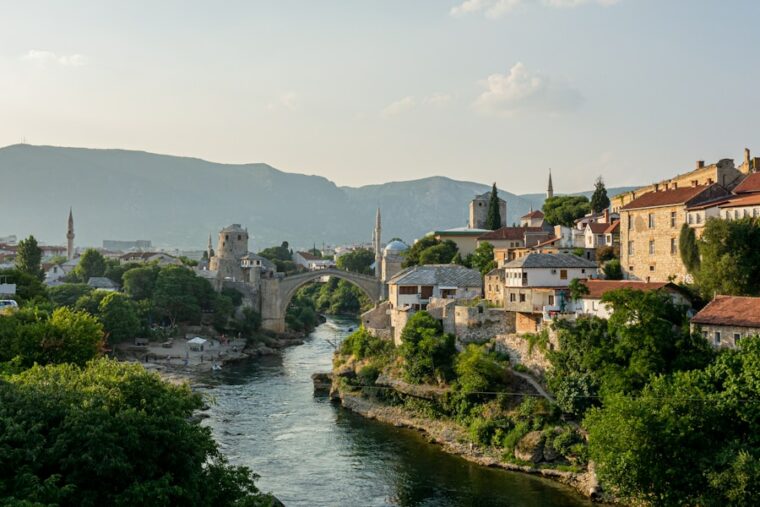Bosnia and Herzegovina, often referred to as simply Bosnia, is a country located in Southeastern Europe on the Balkan Peninsula. It is bordered by Croatia to the north, west, and south, Serbia to the east, and Montenegro to the southeast. The country has a rich and diverse cultural heritage, with influences from the Ottoman Empire, Austro-Hungarian Empire, and the former Yugoslavia. The capital and largest city, Sarajevo, is known for its historical significance and stunning architecture. Bosnia and Herzegovina is also home to a number of natural wonders, including the picturesque Dinaric Alps and the stunning Kravice Waterfalls. With its fascinating history, breathtaking landscapes, and warm hospitality, Bosnia and Herzegovina is a must-visit destination for travelers seeking an authentic and immersive experience.
Bosnia and Herzegovina has a complex and tumultuous history that has left a lasting impact on its culture and heritage. The country was part of the Ottoman Empire for nearly 400 years, which is evident in its architecture, cuisine, and traditions. The Austro-Hungarian Empire also had a significant influence on the region, particularly in Sarajevo, where visitors can see the blend of Eastern and Western architectural styles. In more recent history, Bosnia and Herzegovina was part of the former Yugoslavia, which dissolved in the early 1990s, leading to a devastating war that resulted in significant loss of life and destruction. Despite these challenges, the country has emerged as a resilient and vibrant nation, with a strong sense of national pride and a rich cultural tapestry that is evident in its historic sites, natural wonders, and diverse communities.
Historic Sites: Exploring the Rich Cultural Heritage
Bosnia and Herzegovina is home to a wealth of historic sites that offer a glimpse into its rich cultural heritage. One of the most iconic landmarks is the Stari Most (Old Bridge) in Mostar, which was built in the 16th century during the Ottoman era. The bridge is a symbol of unity and reconciliation, as it was destroyed during the Bosnian War but has since been rebuilt as a testament to the country’s resilience. Visitors can stroll along the cobblestone streets of Mostar’s old town, admiring the traditional Ottoman architecture and browsing the bustling bazaar. Another must-see historic site is the town of Pocitelj, which is perched on a hill overlooking the Neretva River. This well-preserved medieval town features ancient stone houses, mosques, and a fortress that offers panoramic views of the surrounding countryside.
In Sarajevo, history buffs can explore the city’s diverse architectural styles, from the grand Austro-Hungarian buildings in the city center to the charming Ottoman-era neighborhoods with narrow alleyways and ornate mosques. The city is also home to several museums that provide insight into Bosnia and Herzegovina’s complex history, including the Sarajevo War Tunnel Museum, which commemorates the city’s resilience during the siege of Sarajevo in the 1990s. For a deeper understanding of the country’s cultural heritage, visitors can also explore the medieval town of Jajce, with its ancient fortress and stunning waterfall, as well as the UNESCO-listed town of Visoko, known for its medieval royal residence and ancient pyramids.
Natural Wonders: Discovering the Beauty of the Land
Bosnia and Herzegovina boasts an abundance of natural wonders that showcase the country’s diverse landscapes and breathtaking beauty. The Dinaric Alps stretch across much of the country, offering stunning vistas, lush forests, and pristine lakes. One of the most popular destinations in the region is Sutjeska National Park, home to the majestic Perucica primeval forest, one of the last remaining ancient forests in Europe. Visitors can hike through the park’s rugged terrain, marvel at its diverse flora and fauna, and visit the impressive Skakavac Waterfall, which plunges 75 meters into a crystal-clear pool below.
Another natural wonder not to be missed is the Kravice Waterfalls, located near the town of Ljubuski in Herzegovina. This series of cascading waterfalls tumbles over limestone cliffs into a turquoise pool below, creating a mesmerizing spectacle that is perfect for swimming and picnicking. The nearby town of Blagaj is also worth a visit for its stunning natural setting at the source of the Buna River, where visitors can explore the ancient Blagaj Tekke monastery built into the cliffs.
In addition to its mountainous terrain, Bosnia and Herzegovina is also home to several picturesque rivers and lakes that offer opportunities for water-based activities such as rafting, kayaking, and fishing. The Una River, which forms part of the border with Croatia, is renowned for its emerald-green waters and dramatic waterfalls, while Lake Jablanica is a popular spot for boating and relaxation amidst serene surroundings.
Must-See Attractions in Sarajevo: The Capital City’s Top Picks
Sarajevo, the capital city of Bosnia and Herzegovina, is a vibrant metropolis that seamlessly blends East and West, tradition and modernity. The city is steeped in history and culture, with a wealth of attractions that cater to all interests. One of Sarajevo’s most iconic landmarks is the Gazi Husrev-beg Mosque, an architectural masterpiece dating back to the 16th century that showcases exquisite Islamic design and craftsmanship. Nearby, visitors can explore the bustling Baščaršija district, known for its narrow streets lined with traditional shops selling handmade crafts, copperware, and colorful textiles.
For history enthusiasts, Sarajevo offers a number of museums and historic sites that provide insight into the city’s complex past. The Sarajevo War Tunnel Museum offers a poignant look at life during the siege of Sarajevo in the 1990s, while the National Museum of Bosnia and Herzegovina houses an impressive collection of artifacts spanning prehistoric times to modern-day. The Latin Bridge is another significant site in Sarajevo, where Archduke Franz Ferdinand was assassinated in 1914, sparking World War
Sarajevo is also known for its vibrant arts and cultural scene, with numerous galleries, theaters, and music venues that showcase local talent as well as international acts. The city hosts several annual events that celebrate its diverse cultural heritage, including the Sarajevo Film Festival, which attracts filmmakers from around the world, as well as traditional music festivals and dance performances.
Outdoor Adventures: Thrilling Activities for Nature Enthusiasts
For outdoor enthusiasts, Bosnia and Herzegovina offers a wide range of thrilling activities that take advantage of its stunning natural landscapes. The country’s rugged terrain is ideal for hiking and trekking, with countless trails that wind through dense forests, alpine meadows, and remote villages. One of the most popular hiking destinations is Bjelasnica Mountain, which hosted events during the 1984 Winter Olympics and offers panoramic views of the surrounding countryside.
Water sports are also popular in Bosnia and Herzegovina, with opportunities for rafting, kayaking, and canoeing on its pristine rivers. The Neretva River is particularly renowned for its challenging rapids and scenic beauty, making it a favorite among adrenaline junkies. For those seeking a more leisurely experience on the water, Lake Jablanica provides a tranquil setting for boating and fishing amidst serene surroundings.
Cycling has also gained popularity in Bosnia and Herzegovina in recent years, with numerous trails that cater to all skill levels. The country’s diverse landscapes offer varied terrain for mountain biking enthusiasts, from gentle rolling hills to steep mountain passes. Cyclists can explore charming villages, ancient ruins, and scenic viewpoints along well-marked routes that showcase the best of Bosnia and Herzegovina’s natural beauty.
Hidden Gems: Off-the-Beaten-Path Destinations
While Bosnia and Herzegovina has several well-known attractions that draw visitors from around the world, there are also many off-the-beaten-path destinations that offer unique experiences away from the crowds. The town of Trebinje in Herzegovina is one such hidden gem, known for its charming old town with cobblestone streets lined with cafes and shops selling local handicrafts. Visitors can explore historic churches and monasteries in Trebinje’s picturesque surroundings or take a leisurely boat ride on the tranquil Trebisnjica River.
The town of Travnik is another hidden gem that offers a glimpse into Bosnia’s Ottoman past with its well-preserved fortress and traditional Turkish houses. Visitors can wander through Travnik’s atmospheric old town, admiring its ancient mosques and vibrant bazaar while sampling local delicacies such as cevapi (grilled minced meat) and baklava (sweet pastry).
For nature lovers seeking solitude and tranquility, the Una National Park in northwest Bosnia is an idyllic destination with pristine rivers, dense forests, and abundant wildlife. The park’s remote location makes it an ideal spot for hiking, birdwatching, and wildlife photography without the crowds typically found at more popular tourist sites.
Practical Tips for Traveling in Bosnia and Herzegovina
When traveling to Bosnia and Herzegovina, it’s important to be mindful of local customs and traditions to ensure a respectful and enjoyable experience. The country has a diverse population with various ethnic groups including Bosniaks (Bosnian Muslims), Serbs (Orthodox Christians), Croats (Catholics), as well as smaller communities such as Roma and Jews. Visitors should be aware of cultural sensitivities when visiting religious sites or participating in local customs.
Bosnia and Herzegovina uses the convertible mark (BAM) as its currency, which is widely accepted throughout the country. ATMs are readily available in major cities but may be less common in rural areas or smaller towns. Credit cards are accepted at larger establishments such as hotels and restaurants but may not be widely used at smaller shops or markets.
The country has a continental climate with hot summers and cold winters, so it’s important to pack accordingly depending on the time of year you plan to visit. In summer months, lightweight clothing is recommended along with sunscreen and a hat for protection from the sun. In winter months, warm layers are essential along with sturdy footwear for exploring snowy landscapes.
In terms of transportation, Bosnia and Herzegovina has a well-developed road network that makes it easy to travel between cities by car or bus. However, public transportation within cities may be limited so it’s advisable to plan ahead when exploring urban areas. Taxis are readily available in major cities but it’s important to agree on a fare before starting your journey to avoid any misunderstandings.
Overall, Bosnia and Herzegovina offers a wealth of experiences for travelers seeking history, culture, nature, and adventure. With its diverse landscapes, rich heritage, warm hospitality, and off-the-beaten-path destinations waiting to be discovered, this Southeastern European gem is sure to captivate visitors from around the world.


